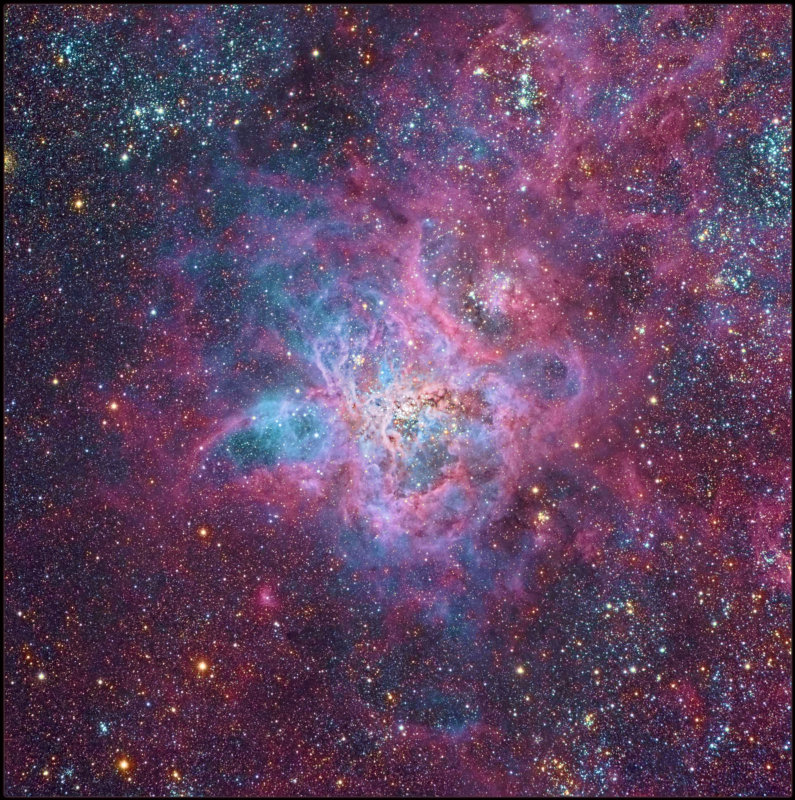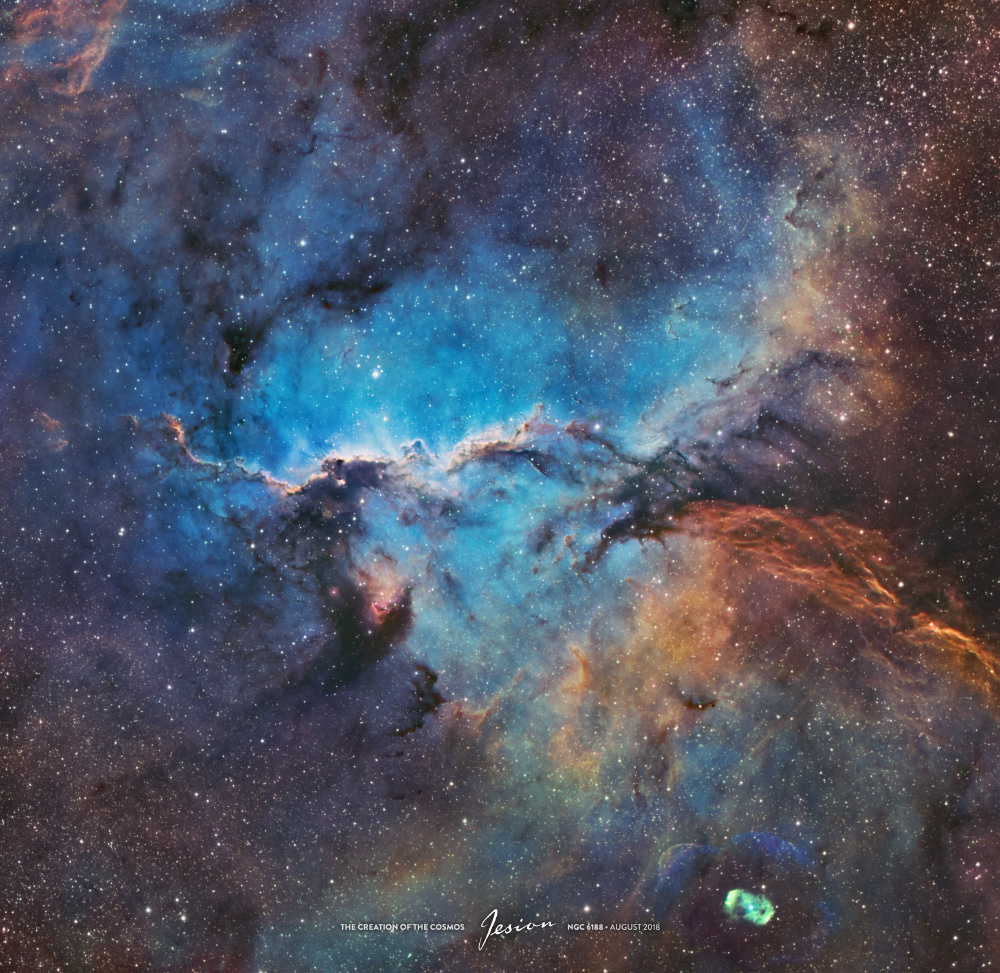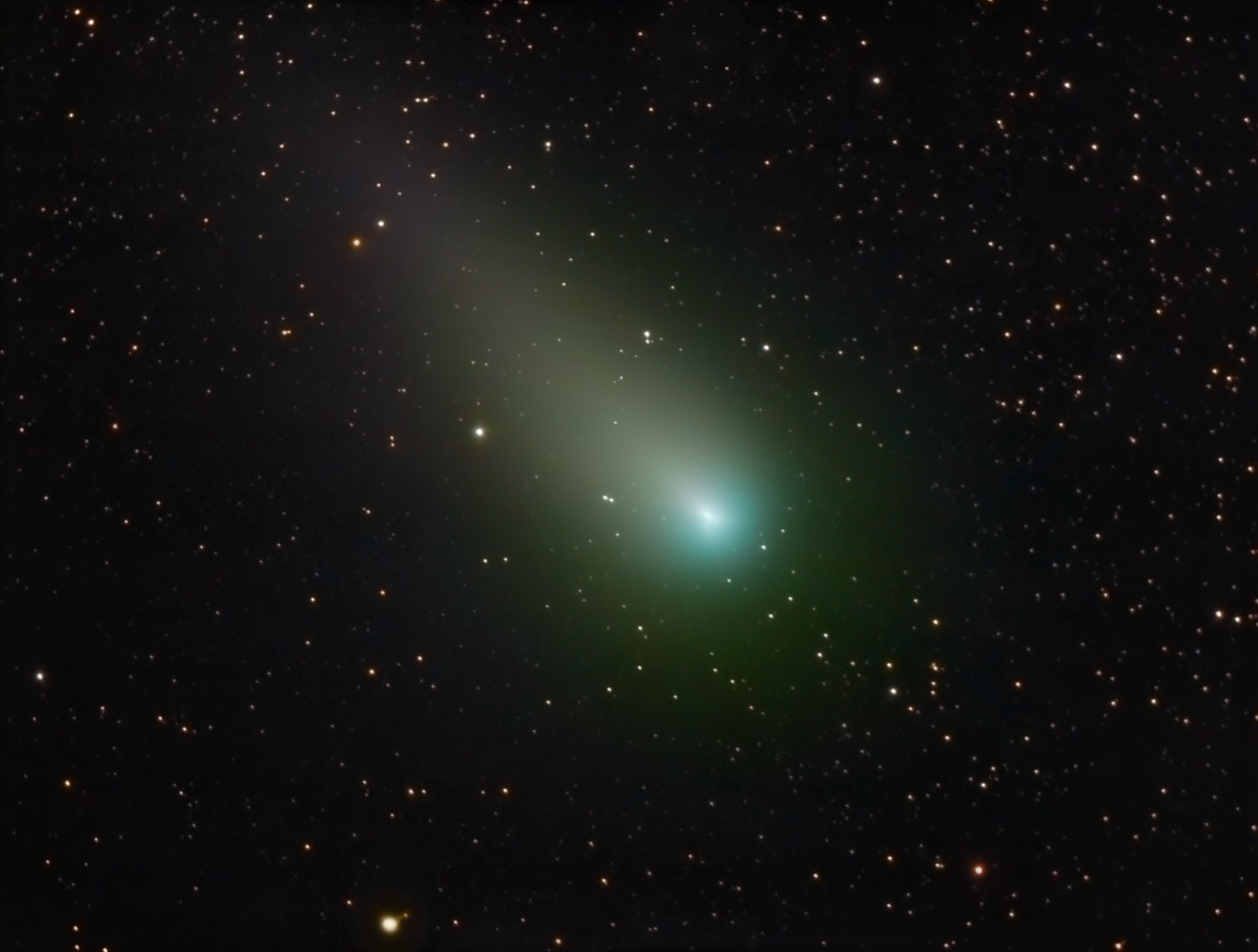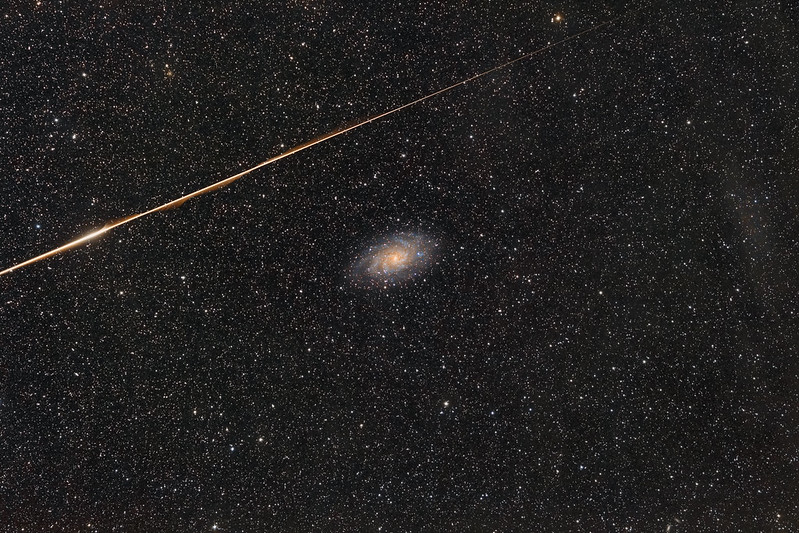Submissions: 2018 August
Re: Submissions: 2018 August
Compositon of the last total lunar eclipse (July, 27 2018) made from 3 frames (ingress, totality, egress) each postprocessed in HDR in order to catch the correct exposition for both the illuminated part of the Moon and the part covered by the Earth shadow.
An apochromatic telescope (72mm f/6) with a telecentric 2.5x Barlow lens has been used together with a DSLR Canon 650D full spectrum modified camera.
Postprocessing by Photoshop CS3.
Images taken from Bari - Italy
Luigi Fiorentino
Hi-Res here
https://flic.kr/p/N2je6N
An apochromatic telescope (72mm f/6) with a telecentric 2.5x Barlow lens has been used together with a DSLR Canon 650D full spectrum modified camera.
Postprocessing by Photoshop CS3.
Images taken from Bari - Italy
Luigi Fiorentino
Hi-Res here
https://flic.kr/p/N2je6N
-
Sebastian Voltmer
- Ensign
- Posts: 67
- Joined: Tue Jan 17, 2012 11:45 pm
Re: Submissions: 2018 August
The bright planet Mars, Milky Way's core and a Perseid Meteor, captured at the westernmost point of the Algarve on the night of August 12 at 23:40 UT.
Our outreach project;
www.apollo-13,eu
sebastian@voltmer.de
Clear Skies,
Sebastian
Our outreach project;
www.apollo-13,eu
sebastian@voltmer.de
Clear Skies,
Sebastian
Re: Submissions: 2018 August
post deleted
Last edited by LuigiF on Fri Aug 17, 2018 10:01 am, edited 3 times in total.
-
KuriousGeorge
- Science Officer
- Posts: 218
- Joined: Wed Dec 30, 2015 7:07 am
- Location: San Diego, CA
- Contact:
Re: Submissions: 2018 August
NGC 7331. KG Observatory, Julian CA.
From August 5th through August 15th we were very fortunate to experience extremely steady, clear and dark skies in Julian, CA. This is the second of 6 objects I captured during this time.
"NGC 7331 is an unbarred spiral galaxy about 40 million light-years away in the constellation Pegasus. It was discovered by William Herschel in 1784. The galaxy is similar in size and structure to the Milky Way, and is often referred to as "the Milky Way's twin". However, discoveries in the 2000s regarding the structure of the Milky Way may call this similarity into doubt, particularly because the latter is now believed to be a barred spiral, compared to the unbarred status of NGC 7331."
Imaging telescope or lens:Planewave CDK24
Imaging camera:FLI Proline 16803
Mount:Planewave L600
Guiding camera:Starlight Xpress Ultrastar
Focal reducer:None
Software:Planewave PWI4, Planewave PWI3, PixInsight 1.8, Maxim DL6, PHD Guiding 2, Neat Image V7, Photoshop CS3, Sequence Generator Pro
Filters:Astrodon 50mm R, Astrodon 50mm B, Astrodon 50 mm G, Astrodon 50mm L
Accessories:FLI CFW-5-7, Astrodon Monster MOAG, Hedrick Focuser, Planewave Delta-T, Planewave EFA
Resolution: 3704x2548
Dates: Aug. 9, 2018, Aug. 10, 2018
Frames:
Astrodon 50 mm G: 8x900" -20C bin 1x1
Astrodon 50mm B: 8x900" -20C bin 1x1
Astrodon 50mm L: 18x900" -20C bin 1x1
Astrodon 50mm R: 8x900" -20C bin 1x1
Integration: 10.5 hours
Darks: ~20
Flats: ~80
Flat darks: ~80
Bias: ~20
Avg. Moon age: 27.88 days
Avg. Moon phase: 3.41%
Mean SQM: 21.60
Astrometry.net job: 2204330
RA center: 339.273 degrees
DEC center: 34.410 degrees
Pixel scale: 0.468 arcsec/pixel
Orientation: 269.352 degrees
Field radius: 0.292 degrees
Locations: KG Observatory, Julian, CA, United States
Data source: Backyard
From August 5th through August 15th we were very fortunate to experience extremely steady, clear and dark skies in Julian, CA. This is the second of 6 objects I captured during this time.
"NGC 7331 is an unbarred spiral galaxy about 40 million light-years away in the constellation Pegasus. It was discovered by William Herschel in 1784. The galaxy is similar in size and structure to the Milky Way, and is often referred to as "the Milky Way's twin". However, discoveries in the 2000s regarding the structure of the Milky Way may call this similarity into doubt, particularly because the latter is now believed to be a barred spiral, compared to the unbarred status of NGC 7331."
Imaging telescope or lens:Planewave CDK24
Imaging camera:FLI Proline 16803
Mount:Planewave L600
Guiding camera:Starlight Xpress Ultrastar
Focal reducer:None
Software:Planewave PWI4, Planewave PWI3, PixInsight 1.8, Maxim DL6, PHD Guiding 2, Neat Image V7, Photoshop CS3, Sequence Generator Pro
Filters:Astrodon 50mm R, Astrodon 50mm B, Astrodon 50 mm G, Astrodon 50mm L
Accessories:FLI CFW-5-7, Astrodon Monster MOAG, Hedrick Focuser, Planewave Delta-T, Planewave EFA
Resolution: 3704x2548
Dates: Aug. 9, 2018, Aug. 10, 2018
Frames:
Astrodon 50 mm G: 8x900" -20C bin 1x1
Astrodon 50mm B: 8x900" -20C bin 1x1
Astrodon 50mm L: 18x900" -20C bin 1x1
Astrodon 50mm R: 8x900" -20C bin 1x1
Integration: 10.5 hours
Darks: ~20
Flats: ~80
Flat darks: ~80
Bias: ~20
Avg. Moon age: 27.88 days
Avg. Moon phase: 3.41%
Mean SQM: 21.60
Astrometry.net job: 2204330
RA center: 339.273 degrees
DEC center: 34.410 degrees
Pixel scale: 0.468 arcsec/pixel
Orientation: 269.352 degrees
Field radius: 0.292 degrees
Locations: KG Observatory, Julian, CA, United States
Data source: Backyard
Re: Submissions: 2018 August
Wolf-Rayet 134
Deep Sky West
Deep Sky West
Re: Submissions: 2018 August
Perseids from Stone Dolls, Kratovo, Macedonia on August 12, 2018. The Stone Dolls are natural geologic phenomenon that resemble human figures, hence the name. In the folklore these rocks are presented as wedding ceremony with bride and groom in the center, guests on the right side and in-laws on the left side.
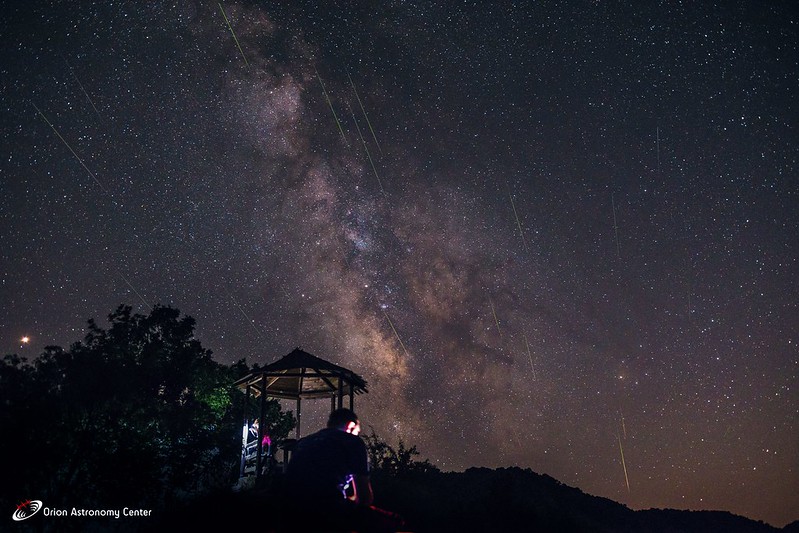
Full res>https://www.flickr.com/photos/13924746@N00/43368117694
This composite photo was made during 90 minutes shooting where 21 Perseids were captured (c) Kristijan Siskovski
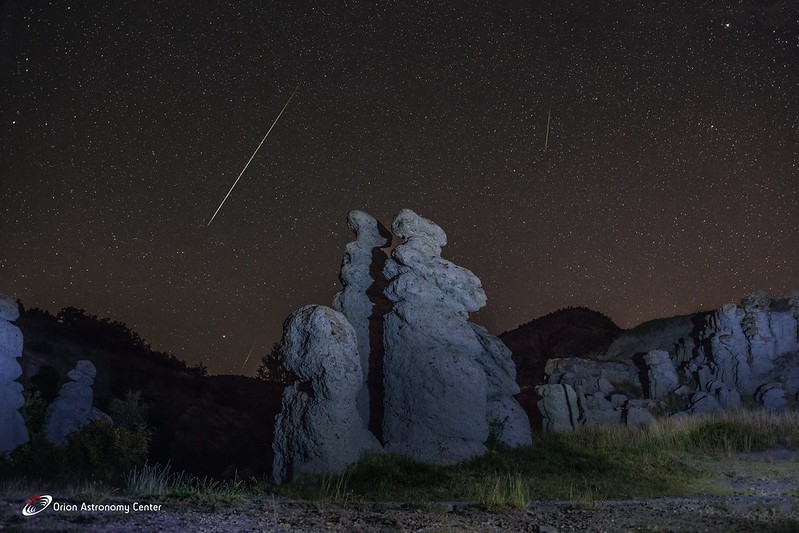
Full res> https://www.flickr.com/photos/13924746@N00/43180276955
This composite photo was made during 30 minutes shooting where 3 Perseids were captured (c) Kristijan Siskovski
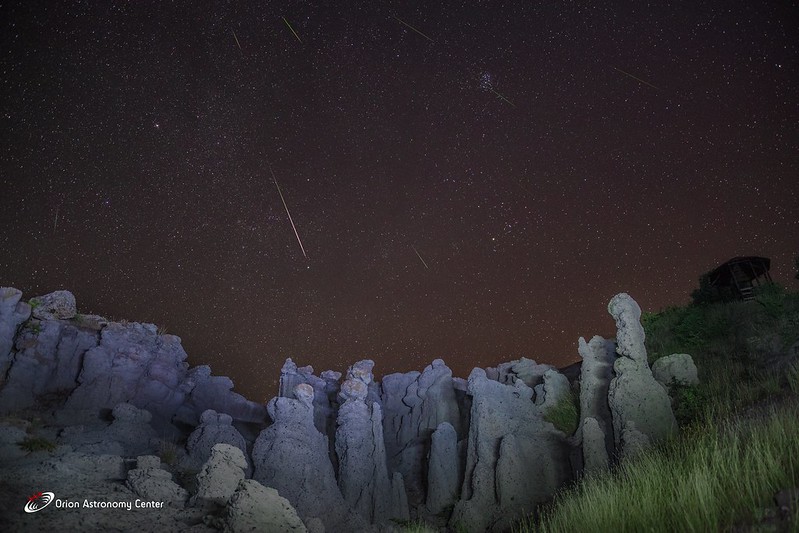
Full res> https://www.flickr.com/photos/13924746@N00/44086965651
This composite photo was made during 45 minutes shooting where 9 Perseids were captured (c) Kristijan Siskovski
Kristijan Siskovski
www.orion.mk

Full res>https://www.flickr.com/photos/13924746@N00/43368117694
This composite photo was made during 90 minutes shooting where 21 Perseids were captured (c) Kristijan Siskovski

Full res> https://www.flickr.com/photos/13924746@N00/43180276955
This composite photo was made during 30 minutes shooting where 3 Perseids were captured (c) Kristijan Siskovski

Full res> https://www.flickr.com/photos/13924746@N00/44086965651
This composite photo was made during 45 minutes shooting where 9 Perseids were captured (c) Kristijan Siskovski
Kristijan Siskovski
www.orion.mk
-
Damian Demendecki
- Asternaut
- Posts: 2
- Joined: Fri Aug 17, 2018 9:26 pm
Re: Submissions: 2018 August
https://image.ibb.co/buQG0z/fireball640.gif
https://image.ibb.co/hjuFtK/fireballs.jpg
Explanation: Brilliant Perseid fireballs captured on 12 of August 2018 at 21:55 UT over Bieszczady mountains in Poland. This particular place is considered without doubts as the darkest site in Poland. The animation is bonus and is built from cropped 30-second exposures taken at ISO 3200, F/2.8. Particularly bright event (-8 mag) that displayed near zenith left beautiful persistent trail and gentle shockwave after couple of minutes. Credits and copyright to Damian Demendecki.
https://image.ibb.co/hjuFtK/fireballs.jpg
Explanation: Brilliant Perseid fireballs captured on 12 of August 2018 at 21:55 UT over Bieszczady mountains in Poland. This particular place is considered without doubts as the darkest site in Poland. The animation is bonus and is built from cropped 30-second exposures taken at ISO 3200, F/2.8. Particularly bright event (-8 mag) that displayed near zenith left beautiful persistent trail and gentle shockwave after couple of minutes. Credits and copyright to Damian Demendecki.
Last edited by bystander on Sat Aug 18, 2018 12:30 am, edited 1 time in total.
Reason: Please, no hotlinks to images > 500Kb.
Reason: Please, no hotlinks to images > 500Kb.
Re: Submissions: 2018 August
Last edited by tango33 on Sat Aug 18, 2018 7:36 pm, edited 3 times in total.
-
SpookyAstro
- Science Officer
- Posts: 117
- Joined: Sat Feb 07, 2015 7:38 pm
Re: Submissions: 2018 August
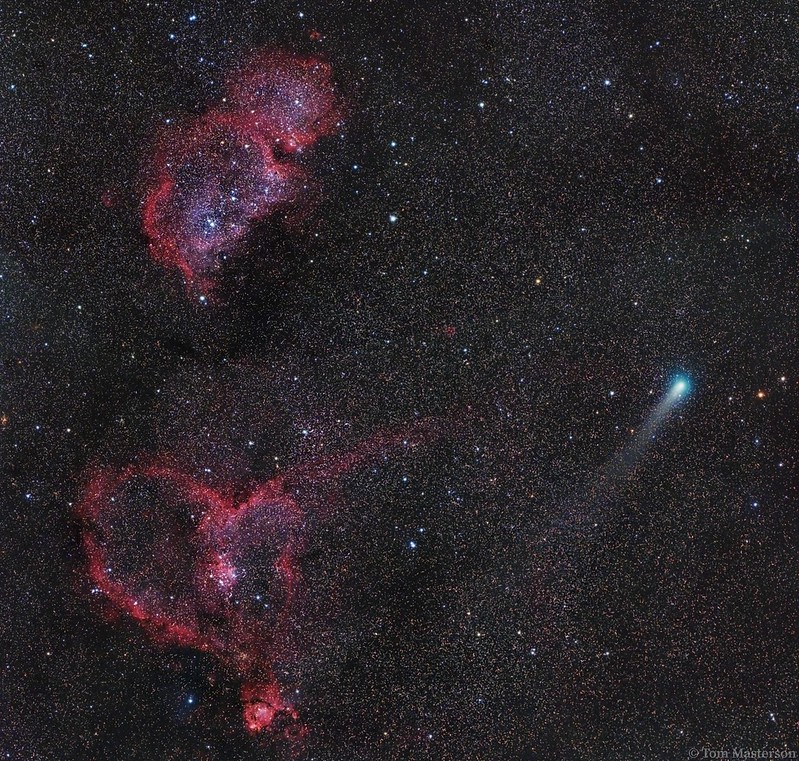 Comet 21P/Giacobini-Zinner Visits the Heart And Soul Nebulae by Transient Astronomer, on Flickr
Comet 21P/Giacobini-Zinner Visits the Heart And Soul Nebulae by Transient Astronomer, on FlickrImage Credit and Copyright Tom Masterson
-
KuriousGeorge
- Science Officer
- Posts: 218
- Joined: Wed Dec 30, 2015 7:07 am
- Location: San Diego, CA
- Contact:
Re: Submissions: 2018 August
Arp 273. KG Observatory, Julian CA.
From August 5th through August 15th we were very fortunate to experience extremely steady, clear and dark skies in Julian, CA. This is the third of 6 objects I captured during this time.
"Arp 273 is a pair of interacting galaxies, lying 300 million light years away in the constellation Andromeda. It was first described in the Atlas of Peculiar Galaxies, compiled by Halton Arp in 1966. The larger of the spiral galaxies, known as UGC 1810, is about five times more massive than the smaller galaxy. It has a disc that is tidally distorted into a rose-like shape by the gravitational pull of the companion galaxy below it, known as UGC 1813. The smaller galaxy shows distinct signs of active star formation at its nucleus, and it is thought that the smaller galaxy has actually passed through the larger one."
Imaging telescope or lens:Planewave CDK24
Imaging camera:FLI Proline 16803
Mount:Planewave L600
Guiding camera:Starlight Xpress Ultrastar
Focal reducer:None
Software:Planewave PWI4, Planewave PWI3, PixInsight 1.8, Maxim DL6, PHD Guiding 2, Neat Image V7, Photoshop CS3, Sequence Generator Pro
Filters:Astrodon 50mm R, Astrodon 50mm B, Astrodon 50 mm G, Astrodon 50mm L
Accessories:FLI CFW-5-7, Astrodon Monster MOAG, Hedrick Focuser, Planewave Delta-T, Planewave EFA
Resolution: 1483x1110
Dates: Aug. 12, 2018, Aug. 13, 2018, Aug. 14, 2018
Frames:
Astrodon 50 mm G: 8x900" -20C bin 1x1
Astrodon 50mm B: 8x900" -20C bin 1x1
Astrodon 50mm L: 19x900" -20C bin 1x1
Astrodon 50mm R: 8x900" -20C bin 1x1
Integration: 10.8 hours
Darks: ~20
Flats: ~80
Flat darks: ~80
Bias: ~20
Avg. Moon age: 2.39 days
Avg. Moon phase: 7.17%
Mean SQM: 21.60
Astrometry.net job: 2205375
RA center: 35.380 degrees
DEC center: 39.377 degrees
Pixel scale: 0.468 arcsec/pixel
Orientation: 89.414 degrees
Field radius: 0.121 degrees
Locations: KG Observatory, Julian, CA, United States
Data source: Backyard
From August 5th through August 15th we were very fortunate to experience extremely steady, clear and dark skies in Julian, CA. This is the third of 6 objects I captured during this time.
"Arp 273 is a pair of interacting galaxies, lying 300 million light years away in the constellation Andromeda. It was first described in the Atlas of Peculiar Galaxies, compiled by Halton Arp in 1966. The larger of the spiral galaxies, known as UGC 1810, is about five times more massive than the smaller galaxy. It has a disc that is tidally distorted into a rose-like shape by the gravitational pull of the companion galaxy below it, known as UGC 1813. The smaller galaxy shows distinct signs of active star formation at its nucleus, and it is thought that the smaller galaxy has actually passed through the larger one."
Imaging telescope or lens:Planewave CDK24
Imaging camera:FLI Proline 16803
Mount:Planewave L600
Guiding camera:Starlight Xpress Ultrastar
Focal reducer:None
Software:Planewave PWI4, Planewave PWI3, PixInsight 1.8, Maxim DL6, PHD Guiding 2, Neat Image V7, Photoshop CS3, Sequence Generator Pro
Filters:Astrodon 50mm R, Astrodon 50mm B, Astrodon 50 mm G, Astrodon 50mm L
Accessories:FLI CFW-5-7, Astrodon Monster MOAG, Hedrick Focuser, Planewave Delta-T, Planewave EFA
Resolution: 1483x1110
Dates: Aug. 12, 2018, Aug. 13, 2018, Aug. 14, 2018
Frames:
Astrodon 50 mm G: 8x900" -20C bin 1x1
Astrodon 50mm B: 8x900" -20C bin 1x1
Astrodon 50mm L: 19x900" -20C bin 1x1
Astrodon 50mm R: 8x900" -20C bin 1x1
Integration: 10.8 hours
Darks: ~20
Flats: ~80
Flat darks: ~80
Bias: ~20
Avg. Moon age: 2.39 days
Avg. Moon phase: 7.17%
Mean SQM: 21.60
Astrometry.net job: 2205375
RA center: 35.380 degrees
DEC center: 39.377 degrees
Pixel scale: 0.468 arcsec/pixel
Orientation: 89.414 degrees
Field radius: 0.121 degrees
Locations: KG Observatory, Julian, CA, United States
Data source: Backyard
-
ashtree
- Ensign
- Posts: 14
- Joined: Thu May 06, 2010 11:53 pm
- AKA: Adam_Jesion
- Location: Warsaw / Poland
- Contact:
Re: Submissions: 2018 August
The Creation of the Cosmos: Tribute to Michelangelo - NGC 6188
https://www.facebook.com/adam.jesionkiewicz
Copyright: Adam Jesionkiewicz
Equipment: ZWO ASI1600MM-C, WO71 APO refractor, iOptron CEM25EC mount
Hi res image: http://bit.ly/2PlENj9
https://www.facebook.com/adam.jesionkiewicz
Copyright: Adam Jesionkiewicz
Equipment: ZWO ASI1600MM-C, WO71 APO refractor, iOptron CEM25EC mount
Hi res image: http://bit.ly/2PlENj9
-
Gianluca Galloni
- Asternaut
- Posts: 5
- Joined: Wed Mar 28, 2018 1:25 pm
Re: Submissions: 2018 August
21P Giacobini-Zinner meets Heart Nebula
Image taken remotely from New Mexico with iTelescope
Copyright: Gianluca Galloni
Here in full resolution: https://flic.kr/p/297iVB5
Image taken remotely from New Mexico with iTelescope
Copyright: Gianluca Galloni
Here in full resolution: https://flic.kr/p/297iVB5
-
KuriousGeorge
- Science Officer
- Posts: 218
- Joined: Wed Dec 30, 2015 7:07 am
- Location: San Diego, CA
- Contact:
Re: Submissions: 2018 August
Trifid Nebula. KG Observatory, Julian, CA.
From August 5th through August 15th we were very fortunate to experience extremely steady, clear and dark skies in Julian, CA. This is the fourth of 6 objects I captured during this time.
"The Trifid Nebula is an H II region located in Sagittarius 5,000 ly from Earth. It was discovered by Charles Messier on June 5, 1764. Its name means 'divided into three lobes'. The object is an unusual combination of an open cluster of stars; an emission nebula (the upper, red portion), a reflection nebula (the lower, blue portion) and a dark nebula (the apparent 'gaps' within the emission nebula that cause the trifurcated appearance; these are also designated Barnard 85). Viewed through a small telescope, the Trifid Nebula is a bright and peculiar object, and is thus a perennial favorite of amateur astronomers.
The Trifid Nebula is a star-forming region in the Scutum spiral arm of the Milky Way. The most massive star that has formed in this region is HD 164492A, an O7.5III star with a mass more than 20 times the mass of the Sun. This star is surrounded by a cluster of approximately 3100 young stars."
Imaging telescope or lens:Planewave CDK24
Imaging camera:FLI Proline 16803
Mount:Planewave L600
Guiding camera:Starlight Xpress Ultrastar
Focal reducer:None
Software:Planewave PWI4, Planewave PWI3, PixInsight 1.8, Maxim DL6, PHD Guiding 2, Neat Image V7, Photoshop CS3, Sequence Generator Pro
Filters:Astrodon 50mm R, Astrodon 50mm B, Astrodon 50 mm G, Astrodon 50mm L
Accessories:FLI CFW-5-7, Astrodon Monster MOAG, Hedrick Focuser, Planewave Delta-T, Planewave EFA
Resolution: 3969x3993
Dates: Aug. 8, 2018
Frames:
Astrodon 50 mm G: 15x120" -20C bin 1x1
Astrodon 50mm B: 15x120" -20C bin 1x1
Astrodon 50mm L: 30x120" -20C bin 1x1
Astrodon 50mm R: 14x120" -20C bin 1x1
Integration: 2.5 hours
Darks: ~20
Flats: ~80
Flat darks: ~80
Bias: ~20
Avg. Moon age: 26.15 days
Avg. Moon phase: 12.39%
Mean SQM: 21.60
Astrometry.net job: 2205529
RA center: 270.619 degrees
DEC center: -22.989 degrees
Pixel scale: 0.468 arcsec/pixel
Orientation: 179.242 degrees
Field radius: 0.366 degrees
Locations: KG Observatory, Julian, CA, United States
Data source: Backyard
From August 5th through August 15th we were very fortunate to experience extremely steady, clear and dark skies in Julian, CA. This is the fourth of 6 objects I captured during this time.
"The Trifid Nebula is an H II region located in Sagittarius 5,000 ly from Earth. It was discovered by Charles Messier on June 5, 1764. Its name means 'divided into three lobes'. The object is an unusual combination of an open cluster of stars; an emission nebula (the upper, red portion), a reflection nebula (the lower, blue portion) and a dark nebula (the apparent 'gaps' within the emission nebula that cause the trifurcated appearance; these are also designated Barnard 85). Viewed through a small telescope, the Trifid Nebula is a bright and peculiar object, and is thus a perennial favorite of amateur astronomers.
The Trifid Nebula is a star-forming region in the Scutum spiral arm of the Milky Way. The most massive star that has formed in this region is HD 164492A, an O7.5III star with a mass more than 20 times the mass of the Sun. This star is surrounded by a cluster of approximately 3100 young stars."
Imaging telescope or lens:Planewave CDK24
Imaging camera:FLI Proline 16803
Mount:Planewave L600
Guiding camera:Starlight Xpress Ultrastar
Focal reducer:None
Software:Planewave PWI4, Planewave PWI3, PixInsight 1.8, Maxim DL6, PHD Guiding 2, Neat Image V7, Photoshop CS3, Sequence Generator Pro
Filters:Astrodon 50mm R, Astrodon 50mm B, Astrodon 50 mm G, Astrodon 50mm L
Accessories:FLI CFW-5-7, Astrodon Monster MOAG, Hedrick Focuser, Planewave Delta-T, Planewave EFA
Resolution: 3969x3993
Dates: Aug. 8, 2018
Frames:
Astrodon 50 mm G: 15x120" -20C bin 1x1
Astrodon 50mm B: 15x120" -20C bin 1x1
Astrodon 50mm L: 30x120" -20C bin 1x1
Astrodon 50mm R: 14x120" -20C bin 1x1
Integration: 2.5 hours
Darks: ~20
Flats: ~80
Flat darks: ~80
Bias: ~20
Avg. Moon age: 26.15 days
Avg. Moon phase: 12.39%
Mean SQM: 21.60
Astrometry.net job: 2205529
RA center: 270.619 degrees
DEC center: -22.989 degrees
Pixel scale: 0.468 arcsec/pixel
Orientation: 179.242 degrees
Field radius: 0.366 degrees
Locations: KG Observatory, Julian, CA, United States
Data source: Backyard
-
HHV
21P/Giacobini-Zinner with Heart- and Soul Nebula + Perseid
Greetings!
Recorded comet 21P/Giacobini-Zinner passing by the famous Heart- and Soul Nebula with my mobile setup - Star Adventurer tracker with 180mm lens and modified full format NIKON DSLR.
Luckily a late Perseid passed the Heart Nebula during recording - see the left side of the heart to find that meteorite!


(c) 2018 by Michael Schmidt
Austria/EUROPE
Recorded comet 21P/Giacobini-Zinner passing by the famous Heart- and Soul Nebula with my mobile setup - Star Adventurer tracker with 180mm lens and modified full format NIKON DSLR.
Luckily a late Perseid passed the Heart Nebula during recording - see the left side of the heart to find that meteorite!

(c) 2018 by Michael Schmidt
Austria/EUROPE
-
astrosirius
- Science Officer
- Posts: 117
- Joined: Fri Nov 23, 2012 11:17 am
- Location: Barcelona Spain
- Contact:
Re: Submissions: 2018 August
IC 5146 Inside the Cocoon Nebula
Inside the Cocoon Nebula is a newly developing cluster of stars. Cataloged as IC 5146, the beautiful nebula is nearly 15 light-years wide, located some 4,000 light years away toward the northern constellation Cygnus. Like other star forming regions, it stands out in red, glowing, hydrogen gas excited by young, hot stars and blue, dust-reflected starlight at the edge of an otherwise invisible molecular cloud. In fact, the bright star near the center of this nebula is likely only a few hundred thousand years old, powering the nebular glow as it clears out a cavity in the molecular cloud's star forming dust and gas. This exceptionally deep color view of the Cocoon Nebula traces tantalizing features within and surrounding the dusty stellar nursery.
Copyright: Lluís Romero Ventura
http://astrophotographysirius.com/
Time Exposure: 50 hours (L-RGB)
Inside the Cocoon Nebula is a newly developing cluster of stars. Cataloged as IC 5146, the beautiful nebula is nearly 15 light-years wide, located some 4,000 light years away toward the northern constellation Cygnus. Like other star forming regions, it stands out in red, glowing, hydrogen gas excited by young, hot stars and blue, dust-reflected starlight at the edge of an otherwise invisible molecular cloud. In fact, the bright star near the center of this nebula is likely only a few hundred thousand years old, powering the nebular glow as it clears out a cavity in the molecular cloud's star forming dust and gas. This exceptionally deep color view of the Cocoon Nebula traces tantalizing features within and surrounding the dusty stellar nursery.
Copyright: Lluís Romero Ventura
http://astrophotographysirius.com/
Time Exposure: 50 hours (L-RGB)
Lluís Romero Ventura
http://astrotolva.com/
http://astrotolva.com/
Re: Submissions: 2018 August
Comet 21P/Giacobinni-Zinner picture
https://www.astrobin.com/users/nvcchr1/
Copyright: Niels V. Christensen The/my astrobin Comet entry, improved quality & resolution,
https://astrob.in/361061/C/
https://www.astrobin.com/users/nvcchr1/
Copyright: Niels V. Christensen The/my astrobin Comet entry, improved quality & resolution,
https://astrob.in/361061/C/
Re: Submissions: 2018 August
-
keesscherer
- Ensign
- Posts: 15
- Joined: Sat Aug 05, 2017 9:50 am
Re: Submissions: 2018 August
 Messier 31 in Andromeda by Kees Scherer, on Flickr
Messier 31 in Andromeda by Kees Scherer, on FlickrV1, "The Star that Changed the Universe" annotated in this image made with 100mm Esprit APO and QHY16200 CCD using 2x drizzle in AstroPixelProcessor. Full info on Flickr.
-
Guest
Re: Submissions: 2018 August
This is not the Fireworks Galaxy
Actually, this is the Triangulum Galaxy (or Messier 33). A fireball happened to pass nearby, leaving its bright trail. The dust cloud at right, is part of the so-called Integrated Flux Nebula. These clouds glow because they reflect the combined light of all the stars in the the Milky Way.
Technical details: Stack of 163 x 60 sec frames (2 h 43 minutes in total), plus one 60 sec frame for the fireball. Samyang 135mm f/2 lens, Canon 550D at ISO 800, Star Adventurer Mini. Frames taken from my suburban backyard during mid-October 2017.
Full-resolution image (Flickr)
Copyright: Manolis Petrakis
Actually, this is the Triangulum Galaxy (or Messier 33). A fireball happened to pass nearby, leaving its bright trail. The dust cloud at right, is part of the so-called Integrated Flux Nebula. These clouds glow because they reflect the combined light of all the stars in the the Milky Way.
Technical details: Stack of 163 x 60 sec frames (2 h 43 minutes in total), plus one 60 sec frame for the fireball. Samyang 135mm f/2 lens, Canon 550D at ISO 800, Star Adventurer Mini. Frames taken from my suburban backyard during mid-October 2017.
Full-resolution image (Flickr)
Copyright: Manolis Petrakis
-
barretosmed
- Science Officer
- Posts: 482
- Joined: Thu Oct 12, 2017 6:04 pm
Re: Submissions: 2018 August
The Large Magellanic Cloud
It was once considered the galaxy closest to us, it was the first time I saw her naked eye,
I was frightened by her proportion to Heaven.
The photo below was a composition of 40 images of 100 seconds and then the subtraction of a single frame was carried out to keep the house underneath (of a lot of work).
More details :
https://www.astrobin.com/full/361784/0/
Equipments
Canon 6d
Lens 50mm 1.8
Mounting pro cen25
40x100 "
1x100 "(landscape)
Iso 1600
Munhoz - Mg
Copyright: Fernando Oliveira de Menezes
It was once considered the galaxy closest to us, it was the first time I saw her naked eye,
I was frightened by her proportion to Heaven.
The photo below was a composition of 40 images of 100 seconds and then the subtraction of a single frame was carried out to keep the house underneath (of a lot of work).
More details :
https://www.astrobin.com/full/361784/0/
Equipments
Canon 6d
Lens 50mm 1.8
Mounting pro cen25
40x100 "
1x100 "(landscape)
Iso 1600
Munhoz - Mg
Copyright: Fernando Oliveira de Menezes
-
barretosmed
- Science Officer
- Posts: 482
- Joined: Thu Oct 12, 2017 6:04 pm
Re: Submissions: 2018 August
A beautiful view of andromeda
During the meeting in munhoz, I had the idea to realize a capture of the galaxy of andromeda and the sky around him. I was impressed by the image, the taste of enjoying our beautiful sky
Better quality access the link below:
https://www.astrobin.com/full/361758/0/
Equipments:
Canon 6D
Lens 50mm F1.8
30 x 100 sec iso 1600
Munhoz - MG - Brazil
Copyright: Fernando Oliveira de Menezes
During the meeting in munhoz, I had the idea to realize a capture of the galaxy of andromeda and the sky around him. I was impressed by the image, the taste of enjoying our beautiful sky
Better quality access the link below:
https://www.astrobin.com/full/361758/0/
Equipments:
Canon 6D
Lens 50mm F1.8
30 x 100 sec iso 1600
Munhoz - MG - Brazil
Copyright: Fernando Oliveira de Menezes
-
barretosmed
- Science Officer
- Posts: 482
- Joined: Thu Oct 12, 2017 6:04 pm
Re: Submissions: 2018 August
VIA LACTEA CENTRAL REGION
The image shows the central region of the lactea, and the contrasts of the nebulae, mainly of the nebula of the lagoon.
In the Image accessed by the link https://www.astrobin.com/full/361582/0/?nc=, above the nebula and trifid, appears Saturn.
We observed several dark nebulae, among them the pipe nebula, the largest at the bottom
Equipments:
Canon 6D
Lens 50mm 1.8
Munhoz - MG - Brazil
08/08/2018
Copyright: Fernando Oliveira de Menezes
The image shows the central region of the lactea, and the contrasts of the nebulae, mainly of the nebula of the lagoon.
In the Image accessed by the link https://www.astrobin.com/full/361582/0/?nc=, above the nebula and trifid, appears Saturn.
We observed several dark nebulae, among them the pipe nebula, the largest at the bottom
Equipments:
Canon 6D
Lens 50mm 1.8
Munhoz - MG - Brazil
08/08/2018
Copyright: Fernando Oliveira de Menezes
-
SpookyAstro
- Science Officer
- Posts: 117
- Joined: Sat Feb 07, 2015 7:38 pm
Re: Submissions: 2018 August
 Comet 21P/Giacobini-Zinner From 8/17/2018 1:27 to 2:22 a.m. PDT by Transient Astronomer, on Flickr
Comet 21P/Giacobini-Zinner From 8/17/2018 1:27 to 2:22 a.m. PDT by Transient Astronomer, on FlickrImage Credit and Copyright Tom Masterson

